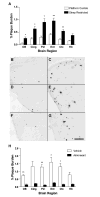Amyloid-beta dynamics are regulated by orexin and the sleep-wake cycle
- PMID: 19779148
- PMCID: PMC2789838
- DOI: 10.1126/science.1180962
Amyloid-beta dynamics are regulated by orexin and the sleep-wake cycle
Abstract
Amyloid-beta (Abeta) accumulation in the brain extracellular space is a hallmark of Alzheimer's disease. The factors regulating this process are only partly understood. Abeta aggregation is a concentration-dependent process that is likely responsive to changes in brain interstitial fluid (ISF) levels of Abeta. Using in vivo microdialysis in mice, we found that the amount of ISF Abeta correlated with wakefulness. The amount of ISF Abeta also significantly increased during acute sleep deprivation and during orexin infusion, but decreased with infusion of a dual orexin receptor antagonist. Chronic sleep restriction significantly increased, and a dual orexin receptor antagonist decreased, Abeta plaque formation in amyloid precursor protein transgenic mice. Thus, the sleep-wake cycle and orexin may play a role in the pathogenesis of Alzheimer's disease.
Figures




References
Publication types
MeSH terms
Substances
Grants and funding
- R01 AG025824/AG/NIA NIH HHS/United States
- K23 AG030946/AG/NIA NIH HHS/United States
- AG030946/AG/NIA NIH HHS/United States
- AG029524/AG/NIA NIH HHS/United States
- NS065667/NS/NINDS NIH HHS/United States
- P30 NS057105/NS/NINDS NIH HHS/United States
- K01 AG029524/AG/NIA NIH HHS/United States
- R01 NS065667/NS/NINDS NIH HHS/United States
- AG025824/AG/NIA NIH HHS/United States
- MH072525/MH/NIMH NIH HHS/United States
- P50 AG005681/AG/NIA NIH HHS/United States
- P30 DK056341/DK/NIDDK NIH HHS/United States
- R01 MH072525/MH/NIMH NIH HHS/United States
LinkOut - more resources
Full Text Sources
Other Literature Sources
Medical
Molecular Biology Databases

